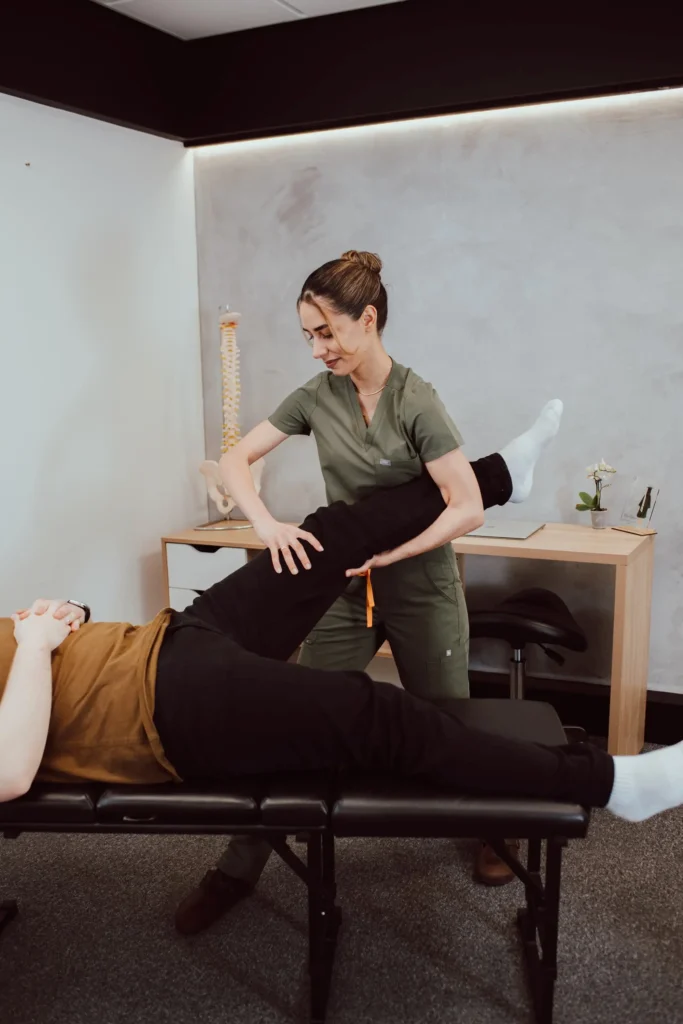Hip
Hip

Common conditions that can present as hip pain include:
Hip Impingement Syndrome (femoroacetabular impingement, i.e., FAI)
It occurs when bony spurs develop around the femoral head (Ball of the hip) pinches against the acetabulum (cup of the hip). This bony overgrowth prevents the hip joint from moving smoothly during activity, leading to pain (in groin area), stiffness and osteoarthritis.
There are two main causes of FAI:
- A deformity of the femoral head (ball of the hip): This is called “cam” impingement where the femoral head is not round and cannot rotate smoothly inside the hip socket.
- A deformity of the socket: This is “pincer” impingement where the front rim of the socket extends out too far and the area of the thigh bone may bump into the rim of the socket during normal hip movements.
Hip impingement treatment include:
- Changing or adapting activities which causes pain
- Exercising as recommended by the doctor or physical therapists
- Taking anti-inflammatory and pain killers
- Manual therapy which can help to strengthen muscles around the hip and relieve inflammation
In certain cases where these treatments have not solved the problem, surgery can be considered where the aim is to alter the bony abnormalities via arthroscopy.
Iliopsoas Bursitis
- Iliopsoas muscle is a strong muscle that plays important role in standing or sitting posture and during walking and turning. Bursa is a slippery sac of fluid located beneath this muscle to provide a cushion and reducing friction between the bone and the muscle. Iliopsoas bursitis is an inflammation of the bursa which make it difficult to walk and exercise. It is mainly caused by certain type of arthritis, acute trauma, and overuse injury. It is usually seen in individuals participating in rowing, uphill running, and strength training.
Common symptoms of iliopsoas bursitis include:
- Pain in front of the hips which travels down the thighs to the knees, especially during activities such as walking upstairs, extending your legs and rising from a seated position.
- Stiffness and tightness in the morning
- Snapping sensation at the front of the hip
Hip Osteoarthritis
Osteoarthritis so called “wear-and-tear-arthritis” is the most common form of joint arthritis and cause of disability in the UK. It can occur in any joint in the body, bust most often develops in weight-bearing joint such as hip and knee.
In non-pharmacological management suggested by NICE guideline, manipulation and stretching should be considered as an adjunct to core treatments, particularly for osteoarthritis of the hip.
The most common symptom of hip osteoarthritis is pain and stiffness. Other symptoms may include:
- Pain in the groin or thigh that travels into the buttocks/knees
- Pain after vigorous activity
- Stiffness and locking of the joint during movement
- Decreased mobility
Since osteoarthritis gradually aggravates over time, the sooner you start the treatment, the more likely it is that you can lessen its impact on your life. There is no cure for osteoarthritis however there are number of treatments to help relieve the symptoms:
- Lifestyle modifications such as stitching from high-impact activities like running to lower impact activities like swimming; losing weight can reduce the stress on the hip joint.
- Manual therapy to help increase mobility and flexibility as well as strengthening hip muscles.
- Supportive treatment: TENS machine and applying hot or cold pack.
Your doctor may recommend surgery if the pain causes disability and is not relieved with non-surgical treatments. Arthroplasty or joint replacement is the most common hip and knee replacement surgery in which your surgeon will remove the affected joint and replace it with an artificial (prosthesis) joint.
Iliotibial Band/Snapping Hip Syndrome
- It is a condition in which feel snapping sensation or hear a popping sound in your hip when you walk, get up or swing your legs. In most cases, snapping hip is the result of tightness in the muscles and tendons surrounding the hip, causing them to move over a bony protrusion in your hip. Dancers and young athletes are more vulnerable to this condition.
Some of the symptoms of snapping hip syndrome may include:
- Reduced hip mobility
- Tightness in the hip
- Swelling in the hip
- Weakness in the leg
Unless snapping hip syndrome is painful or lead to difficulty in doing sports or other activities, most people do not see a doctor.
According to NICE guideline, if the conservative options fail to provide improvement in the symptoms, physical therapy with emphasis on stretching, strengthening can help. Sometimes, your doctor may recommend corticosteroid injection depending on the cause of the snapping hip. In rare cases, doctors may consider surgery.
What Our Clients Say

I got in touch with osteoandspinal after my second knee surgery as I was concerned about my recovery. After my initial consultation, Mahsa explained the issue and laid out a thorough plan for rehabilitating my knee. Following the recommended exercises and after a few adjustments, I’m already feeling stronger and more confident. I am very pleased with the results and would highly recommend osteoandspinal clinic.
Aryan R

I can’t recommend this place enough! I visited osteoandspinal during my pregnancy when I developed a severe back pain. Mahsa made me feel comfortable and at ease by explaining all aspects of the treatment. Over the next couple of visits, she managed to reduce the pain through adjustments and acupuncture.
Sophia O
Ready To Book?
If you would like to arrange an appointment you can book online by clicking below. Alternatively you can get in touch with us on 07464 637437 or reception@osteoandspinal.co.uk
